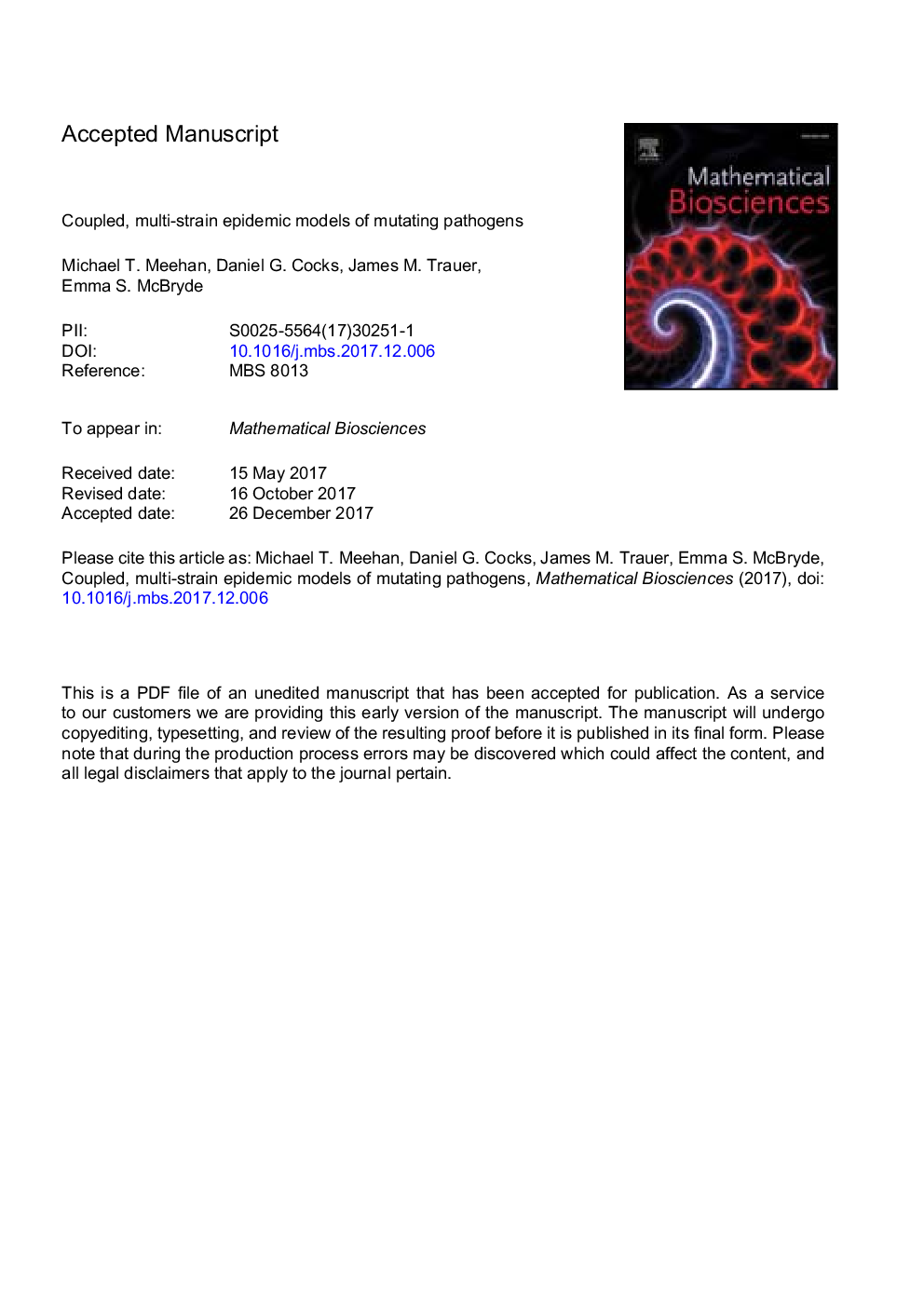| کد مقاله | کد نشریه | سال انتشار | مقاله انگلیسی | نسخه تمام متن |
|---|---|---|---|---|
| 8877083 | 1623984 | 2018 | 37 صفحه PDF | دانلود رایگان |
عنوان انگلیسی مقاله ISI
Coupled, multi-strain epidemic models of mutating pathogens
ترجمه فارسی عنوان
مدل های اپیدمی مولکولی چندگانه، از پاتوژن های جهش،
دانلود مقاله + سفارش ترجمه
دانلود مقاله ISI انگلیسی
رایگان برای ایرانیان
کلمات کلیدی
مقاومت در برابر مواد مخدر، سیر تکاملی، همراه با چند سویه،
ترجمه چکیده
ما معرفی و تجزیه و تحلیل مدل های اپیدمی مولکولی متصل شده، به منظور شبیه سازی ظهور و انتشار گونه های پاتوژن موتانت (به عنوان مثال مقاوم در برابر دارو) طراحی شده است. به طور خاص، خواص ریاضی و بیولوژیکی کلاس کلی مدل های اپیدمی چند نژادی را بررسی می کنیم که در آن بخش های عفونی هر نوع سوسپانسیون به طور کلی به یکدیگر متصل می شوند. ما عبارات صریح برای تعداد بازتولید اساسی هر کشف را به دست می آوریم و اهمیت آنها را در تنظیم دینامیک سیستم (مثلا پتانسیل شیوع اپیدمی) و وجود راه حل های اندمیک غیر انتزاعی را مشخص می کنیم. مهم است که متوجه می شویم که تعداد تولید اساسی هر سویه مستقل از نرخ جهش بین سوپرمارکت ها است - حتی تحت فرض کاملا عمومی برای شکل کوپلینگ محفظه عفونی. علاوه بر این، ما تأیید می کنیم که اصطلاح کوپلینگ همزیستی کشوری را به عنوان یک فرمت اصل محرومیت رقابتی ترویج می دهد و نشان می دهد که فشار با بیشترین ظرفیت تولید مثل لزوما بیشترین شایع نیست. در نهایت، ما به طور خلاصه در مورد پیامدهای نتایج ما برای سیاست های بهداشت عمومی و برنامه ریزی صحبت می کنیم.
موضوعات مرتبط
علوم زیستی و بیوفناوری
علوم کشاورزی و بیولوژیک
علوم کشاورزی و بیولوژیک (عمومی)
چکیده انگلیسی
We introduce and analyze coupled, multi-strain epidemic models designed to simulate the emergence and dissemination of mutant (e.g. drug-resistant) pathogen strains. In particular, we investigate the mathematical and biological properties of a general class of multi-strain epidemic models in which the infectious compartments of each strain are coupled together in a general manner. We derive explicit expressions for the basic reproduction number of each strain and highlight their importance in regulating the system dynamics (e.g. the potential for an epidemic outbreak) and the existence of nonnegative endemic solutions. Importantly, we find that the basic reproduction number of each strain is independent of the mutation rates between the strains - even under quite general assumptions for the form of the infectious compartment coupling. Moreover, we verify that the coupling term promotes strain coexistence (as an extension of the competitive exclusion principle) and demonstrate that the strain with the greatest reproductive capacity is not necessarily the most prevalent. Finally, we briefly discuss the implications of our results for public health policy and planning.
ناشر
Database: Elsevier - ScienceDirect (ساینس دایرکت)
Journal: Mathematical Biosciences - Volume 296, February 2018, Pages 82-92
Journal: Mathematical Biosciences - Volume 296, February 2018, Pages 82-92
نویسندگان
Michael T. Meehan, Daniel G. Cocks, James M. Trauer, Emma S. McBryde,
